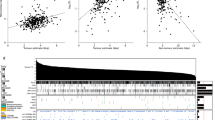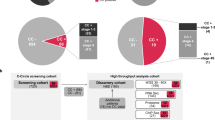Abstract
To get an insight into the transition from mononuclear Hodgkin cells (H cells) to diagnostic multinuclear Reed–Sternberg cells (RS cells), we performed an analysis of the three-dimensional (3D) structure of the telomeres in the nuclei of the Hodgkin cell lines HDLM-2, L-428, L-1236 and lymph node biopsies of patients with Hodgkin's disease. Cellular localization of key proteins of the telomere-localized shelterin complex, the mitotic spindle and double-stranded DNA breaks was also analyzed. RS cells show significantly shorter and significantly fewer telomeres in relation to the total nuclear volume when compared with H cells; in particular, telomere-poor ‘ghost’ nuclei are often adjacent to one or two nuclei displaying huge telomeric aggregates. Shelterin proteins are mainly cytoplasmic in both H and RS cells, whereas double-stranded DNA breaks accumulate in the nuclei of RS cells. In RS cells, multipolar spindles prevent proper chromosome segregation. In conclusion, a process of nuclear disorganization seems to initiate in H cells and further progresses when the cells turn into RS cells and become end-stage tumor cells, unable to divide further because of telomere loss, shortening and aggregate formation, extensive DNA damage and aberrant mitotic spindles that may no longer sustain chromosome segregation. Our findings allow a mechanistic 3D understanding of the transition of H to RS cells.
This is a preview of subscription content, access via your institution
Access options
Subscribe to this journal
Receive 12 print issues and online access
$259.00 per year
only $21.58 per issue
Buy this article
- Purchase on Springer Link
- Instant access to full article PDF
Prices may be subject to local taxes which are calculated during checkout







Similar content being viewed by others
References
Küppers R, Rajewsky K . The origin of Hodgkin and Reed/Sternberg cells in Hodgkin's disease. Annu Rev Immunol 1998; 16: 471–493.
Müschen M, Rajewsky K, Bräuninger A, Baur AS, Oudejans JJ, Roers A et al. Rare occurrence of classical Hodgkin's disease as a T cell lymphoma. J Exp Med 2000; 191: 387–394.
Knecht H, Bachmann E, Brousset P, Sandvej K, Nadal D, Bachmann F et al. Deletions within the LMP1 oncogene of Epstein–Barr virus are clustered in Hodgkin's disease and identical to those observed in nasopharyngeal carcinoma. Blood 1993; 82: 2937–2942.
Skinnider BF, Mak TW . The role of cytokines in classical Hodgkin lymphoma. Blood 2002; 99: 4289–4297.
Schaadt M, Fonatsch C, Kirchner H, Diehl V . Establishment of a malignant, Epstein–Barr-virus (EBV)-negative cell-line from the pleura effusion of a patient with Hodgkin's disease. Blut 1979; 38: 185–190.
Drexler HG, Gignac SM, Hoffbrand AV, Minowada J . Formation of multinucleated cells in a Hodgkin's-disease-derived cell line. Int J Cancer 1989; 43: 1083–1090.
Wolf J, Kapp U, Bohlen H, Kornacker M, Schoch C, Stahl B et al. Peripheral blood mononuclear cells of a patient with advanced Hodgkin's lymphoma give rise to permanently growing Hodgkin-Reed Sternberg cells. Blood 1996; 87: 3418–3428.
Hsu SM, Zhao X, Chakraborty S, Liu YF, Whang-Peng J, Lok MS et al. Reed–Sternberg cells in Hodgkin's cell lines HDLM, L-428, and KM-H2 are not actively replicating: lack of bromodeoxyuridine uptake by multinuclear cells in culture. Blood 1988; 71: 1382–1389.
Pihan GA, Purohit A, Wallace J, Knecht H, Woda B, Quesenberry P et al. Centrosome defects and genetic instability in malignant tumors. Cancer Res 1998; 58: 3974–3985.
MacLeod RA, Spitzer D, Bar-Am I, Sylvester JE, Kaufmann M, Wernich A et al. Karyotypic dissection of Hodgkin's disease cell lines reveals ectopic subtelomeres and ribosomal DNA at sites of multiple jumping translocations and genomic amplification. Leukemia 2000; 14: 1803–1814.
Bailey SM, Murnane JP . Telomeres, chromosome instability and cancer. Nucleic Acid Res 2006; 34: 2408–2417.
Mai S, Garini Y . The significance of telomeric aggregates in the interphase nuclei of tumor cells. J Cell Biochem 2006; 97: 904–915.
LeBel C, Wellinger RJ . Telomeres: what's new at your end? J Cell Science 2005; 118: 2785–2788.
De Lange T . Shelterin: the protein complex that shapes and safeguards human telomeres. Gene Dev 2005; 19: 2100–2110.
Hug N, Lingner J . Telomere length homeostasis. Chromosoma 2006; 115: 413–425.
Brousset P, Al Saati T, Chaouche N, Zenou RC, Schlaifer D, Chittal S et al. Telomerase activity in reactive and neoplastic lymphoid tissue: infrequent detection of activity in Hodgkin's disease. Blood 1997; 89: 26–31.
Norrback KF, Enblad G, Erlanson M, Sundström C, Roos G . Telomerase activity in Hodgkin's disease. Blood 1998; 92: 567–573.
Heine B, Hummel M, Demel G, Stein H . Hodgkin and Reed–Sternberg cells of classical Hodgkin's disease overexpress the telomerase RNA template (hTR). J Pathol 1999; 188: 139–145.
Fukasawa K, Wiener F, Vande Woude GF, Mai S . Genomic instability and apoptosis are frequent in p53 deficient young mice. Oncogene 1997; 15: 1295–1302.
Figueroa R, Lindenmaier H, Hergenhan M, Nielsen KV, Boukamp P . Telomere erosion varies during in vitro aging of normal human fibroblasts from young and adult donors. Cancer Res 2000; 60: 2770–2774.
Chuang TC, Moshir S, Garini Y, Chuang AYC, Young IT, Vermolen B et al. The three-dimensional organization of telomeres in the nucleus of mammalian cells. BMC Biol 2004; 2: 12.
Louis SF, Vermolen BJ, Garini Y, Young IT, Guffei A, Lichtensztein Z et al. C-Myc induces chromosomal rearrangements through telomere and chromosome remodeling in the interphase nucleus. Proc Natl Acad Sci USA 2005; 102: 9613–9618.
Schaefer LH, Schuster D, Herz H . Generalized approach for accelerated maximum likelihood based image restoration applied to three-dimensional fluorescence microscopy. J Microsc 2001; 204: 99–107.
Vermolen BJ, Garini Y, Mai S, Mougey V, Fest T, Chuang TC et al. Characterizing the three-dimensional organization of telomeres. Cytometry A 2005; 67: 144–150.
Poon SS, Martens UM, Ward RK, Lansdorp PM . Telomere length measurements using digital fluorescence microscopy. Cytometry 1999; 36: 267–278.
Sarkar R, Guffei A, Vermolen BJ, Garini Y, Mai S . Alterations of centromere positions in nuclei of immortalized and malignant mouse lymphocytes. Cytometry A 2007; 71: 386–392.
Küppers R, Bräuninger A, Müschen M, Distler V, Hansmann ML, Rajewsky K . Evidence that Hodgkin and Reed–Sternberg cells in Hodgkin disease do not represent cell fusions. Blood 2001; 97: 818–821.
Re D, Benenson E, Beyer M, Gresch O, Draube A, Diehl V et al. Cell fusion is not involved in the generation of giant cells in the Hodgkin-Reed Sternberg cell line L-1236. Am J Hematol 2001; 67: 6–9.
Martin-Subero JI, Knippschild U, Harder L, Barth TF, Riemke J, Grohmann S et al. Segmental chromosomal aberrations and centrosome amplifications: pathogenetic mechanisms in Hodgkin and Reed–Sternberg cells of classical Hodgkin's lymphoma. Leukemia 2003; 17: 2214–2219.
Martin-Subero JI, Klapper W, Sotnikova A, Callet-Bauchu E, Harder L, Bastard C et al. Chromosomal breakpoints affecting immunoglobulin loci are recurrent in Hodgkin and Reed–Sternberg cells of classical Hodgkin lymphoma. Cancer Res 2006; 66: 10332–10338.
Re D, Zander T, Diehl V, Wolf J . Genetic instability in Hodgkin's lymphoma. Ann Oncol 2002; 13: 19–22 (Suppl 1).
Kim NW, Piatyszek MA, Prowse KR, Harley CW, West MD, Ho PL et al. Specific association of human telomerase activity with immortal cells and cancer. Science 1994; 266: 2011–2015.
Blasco MA, Rizen M, Greider CW, Hanahan D . Differential regulation of telomerase activity and telomerase RNA during multi-stage tumorigenesis. Nat Genet 1996; 12: 200–204.
M'Kacher R, Bennacoeur-Griscelli A, Girinsky T, Koschielny S, Delhommeau F, Dossou J et al. Telomere shortening and associated chromosomal instability in peripheral blood lymphocytes of patients with Hodgkin's lymphoma prior to any treatment are predictive of second cancers. Int J Radiat Oncol Biol Phys 2007; 68: 465–471.
Widmann TA, Herrmann M, Taha N, König J, Pfreundschuh M . Short telomeres in aggressive non-Hodgkin's lymphoma as a risk factor in lymphomagenesis. Exp Hematol 2007; 35: 939–946.
Stewénius Y, Gorunova L, Jonson T, Larsson N, Höglund M, Mandahl N et al. Structural and numerical chromosome changes in colon cancer develop through telomere-mediated anaphase bridges, not through mitotic multipolarity. Proc Natl Acad Sci USA 2005; 102: 5541–5546.
Gisselsson D, Jonson T, Petérsen A, Strömbeck B, Dalcin P, Höglund M et al. Telomere dysfunction triggers extensive DNA fragmentation and evolution of complex chromosome abnormalities in human malignant tumors. Proc Natl Acad Sci USA 2001; 98: 12683–12688.
Romanov SR, Kozakiewicz BK, Holst CR, Stampfer MR, Haupt LM, Tlsty TD . Normal human mammary epithelial cells spontaneously escape senescence and acquire genomic changes. Nature 2001; 409: 633–637.
Savage SA, Chanock SJ, Lissowska J, Brinton LA, Richesson D, Peplonska B et al. Genetic variation in five genes important in telomere biology and risk for breast cancer. Br J Cancer 2007; 97: 832–836.
Berezney R, Coffey DS . Nuclear matrix. Isolation and characterization of a framework structure from rat liver nuclei. J Cell Biol 1977; 73: 616–637.
Cremer T, Cremer M, Dietzel S, Muller S, Solovei I, Fakan S . Chromosome territories—a functional nuclear landscape. Curr Opin Cell Biol 2006; 18: 307–316.
De Lange T . Human telomeres are attached to the nuclear matrix. EMBO J 1992; 11: 717–724.
Coffey DS . Nuclear matrix proteins as proteomic markers of preneoplastic and cancer lesions. Clin Cancer Res 2002; 8: 3039–3045.
Broccoli B, Smogorzewska A, Chong L, de Lange T . Human telomeres contain two distinct Myb-related proteins, TRF1 and TRF2. Nat Genet 1997; 17: 231–235.
Chen LY, Liu D, Songyang Z . Telomere maintenance through spatial control of telomeric proteins. Mol Cell Biol 2007; 27: 5898–5909.
Nijjar T, Bassett E, Garbe J, Takenaka Y, Stampfer MR, Gilley D et al. Accumulation and altered localization of telomere-associated protein TRF2 in immortally transformed and tumor-derived human brest cells. Oncogene 2005; 24: 3369–3376.
Re D, Benenson L, Wickenhauser C, Starostik P, Starostik-Jox A, Müller-Hermelink HK et al. Proficient mismatch repair protein expression in Hodgkin and Reed–Sternberg cells. Int J Cancer 2002; 97: 205–210.
Pihan GA, Wallace J, Zhou YN, Doxsey SJ . Centrosome abnormalities and chromosome instability occur together in pre-invasive carcinomas. Cancer Res 2003; 63: 1398–1404.
Salisbury JL, D'Assoro AB, Lingle WL . Centrosome amplification and the origin of chromosomal instability in brest cancer. J Mammary Gland Biol Neoplasia 2004; 9: 275–283.
Acknowledgements
This research is supported by the NCIC/Canadian Cancer Society (grants 16100 to SM and 017116 to RJW) and by the Centre de Recherche Clinique du CHUS (grant PAFI 90914 to HK). We thank Mary Cheang, PhD, University of Manitoba Biostatistics Unit, for statistical analysis of data.
Author information
Authors and Affiliations
Corresponding author
Additional information
Supplementary Information accompanies the paper on the Leukemia website (http://www.nature.com/leu)
Supplementary information
Rights and permissions
About this article
Cite this article
Knecht, H., Sawan, B., Lichtensztejn, D. et al. The 3D nuclear organization of telomeres marks the transition from Hodgkin to Reed–Sternberg cells. Leukemia 23, 565–573 (2009). https://doi.org/10.1038/leu.2008.314
Received:
Revised:
Accepted:
Published:
Issue Date:
DOI: https://doi.org/10.1038/leu.2008.314
Keywords
This article is cited by
-
Disruption of direct 3D telomere–TRF2 interaction through two molecularly disparate mechanisms is a hallmark of primary Hodgkin and Reed–Sternberg cells
Laboratory Investigation (2017)
-
Reed-Sternberg cells in Hodgkin’s lymphoma present features of cellular senescence
Cell Death & Disease (2016)
-
Gene dosage reductions of Trf1 and/or Tin2 induce telomere DNA damage and lymphoma formation in aging mice
Leukemia (2016)
-
Superresolution imaging of telomeres with continuous wave stimulated emission depletion (STED) microscope
Science China Chemistry (2016)
-
3D organization of telomeres in porcine neutrophils and analysis of LPS-activation effect
BMC Cell Biology (2013)



